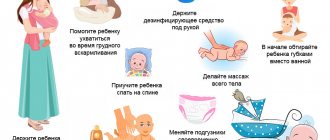Establishing a diagnosis of ectopia during an examination by a gynecologist raises the question of treatment for a woman. Doubt about whether it is necessary to cauterize erosion is based on prejudice about the painfulness and harm of the procedure. Delaying treatment destabilizes the body and may cause difficulty conceiving in the future.
The absence of symptoms during cervical erosion does not alarm a woman and she learns about the diagnosis, most often, during a routine examination by a gynecologist. In most cases, the doctor does not detail the patient’s condition and the decision on treatment is made intuitively.
Information about whether nulliparous women can cauterize erosion will allow them to make an informed decision about timely and adequate treatment.
Myth: Herpes only affects the skin
This is not true at all. The herpes simplex virus is integrated into the genome of nerve cells, so rashes occur at the sites of nerve endings and are accompanied by severe pain. Theoretically, herpes can appear anywhere there is nervous tissue, which means in almost any organ. With a decrease in general and local immunity, a herpetic rash can develop in the mucous membrane of the mouth and larynx, cornea and conjunctiva of the eye, lymph nodes, genitals, intestines, liver, kidneys, lungs.
Iodine alternative
Medicine suggests replacing an alcohol solution of iodine. These drugs are less concentrated and have a less aggressive effect on the skin.
| Iodinol | A mixture of iodine and polyvinyl alcohol |
| Iodonate | Compound of iodine and potassium iodide |
| Lugol's solution | Complex of iodine with aqueous solution of potassium iodide |
| Povidone-Iodine | Iodine with polyvinylpyrrolidone |
These medications can be used at home. They can remove papillomas on the foot, face, back and neck. The recovery period will last a little longer, but the risk of adverse reactions will also decrease.
Medicine pays special attention to Povidone-iodine. It has been used in home treatment since 1960. The solution is gentle on wounds, unlike alkalis or phenols.
The product has a number of medicinal properties:
- fungicidal,
- bactericidal,
- antimicrobial,
- antiviral,
- virucidal.
Povidone-iodine is used mainly externally for several days in a row. Disinfecting baths are made from an antimicrobial blue solution for complete hygienic treatment of the patient. It should be used with caution by pregnant women and during lactation.
Myth: You can be cured by cauterizing the rash with alcohol, iodine and brilliant green.
Unfortunately no. Cauterization does not affect the herpes virus and its activity, but burns to damaged skin and mucous membranes are possible. It is better to carefully lubricate the rash with an antiseptic that does not contain alcohol (this will prevent the addition of a purulent infection).
Article on the topic Herpes: causes, symptoms and treatment And herpes itself is treated with special antiviral drugs (the most famous and common is acyclovir). For frequent exacerbations, medications that strengthen the immune system and general restoratives are also used.
Alcohol for herpes on lips
For reference. Modern medicine has not yet developed effective methods for treating herpes. Even if the symptoms of the disease are eliminated and a state of remission is achieved, the disease may manifest itself again after a certain time.
In this regard, people suffering from pathology resort to self-medication. One of its forms is cauterization of herpetic formations with ethyl alcohol. Is it possible to burn herpes with alcohol or should you not do it?
In order to understand how effective the use of an alcohol solution is to combat a disease, you need to understand the mechanism of its occurrence, as well as take a closer look at the properties of alcohol.
The pathology is caused by the herpes virus. In this case, infection and development of the virus occurs in several stages.
Here are the main ones:
- Attachment. The virus attaches to the cell membrane of one of the body's cells. In this case, the protein of the pathogen and the protein that makes up the cell membrane are interconnected, and the cell begins to consider the virus as part of itself.
- Penetration. At this stage, the herpes virus penetrates the cell membrane through the cell membrane to subsequently introduce its genome into its nucleus.
- Shell reset. Before penetration, the pathogen is contained in a protective shell resembling a capsule. Once it is in the cytoplasm, it discards it.
- Implementation into the kernel. When the shell is shed, the viral pathogen invades the cell nucleus and changes its behavior: it begins to produce other viruses using the body’s resources.
As you can see, the life cycle is different from that of bacteria, which are the causative agents of some diseases. This means that products that can kill bacteria will not be suitable for killing viruses. To combat them, separate drugs are being developed.
They can act in two ways:
- strengthening the immune system, leading to an increase in the activity of lymphocytes and, as a result, a more effective fight of the body against the causative agent of the disease;
- disruption of one of the stages of the life cycle of the pathogen or chemical reactions occurring during the life of the virus, or the breakdown of the proteins of which it consists.
Alcohol is nothing more than an antiseptic. It is capable of destroying gram-positive and gram-negative microorganisms. Although it can affect viral pathogens, such effects are minimal and ineffective.
Attention. Fighting the herpes virus with alcohol is ineffective.
Myth: Condoms protect against genital herpes
A condom really reduces the risk of infection, so its use is necessary during an exacerbation of the disease, in the presence of inflammatory changes on the mucous membranes and skin of the genital organs.
Article on the topic
What folk methods will help get rid of fever on the lip? But, unfortunately, he does not give a 100% guarantee. Transmission of the virus can occur through areas of the body not covered by a condom. Therefore, if possible, you should abstain from sexual activity during the period of exacerbation of the disease.
Alternative Treatments
Is cauterization necessary for cervical erosion? To answer this question, the doctor needs time. If the results of extended colposcopy are good, then treatment is performed using alternative methods. The patient is usually prescribed:
- the use of vaginal suppositories that accelerate regeneration processes;
- the use of chemicals to treat the eroded area of the mucosa;
- douching with antiseptic and anti-inflammatory compounds.
Women use unconventional remedies to treat erosion on their own. However, doctors warn that self-medication can lead to adverse consequences and provoke the spread of the inflammatory process along the ascending path. Therefore, it is better to think several times about whether it is necessary to cauterize the erosion or whether to abandon this manipulation.
You should know it
Test yourself
If rashes appear no more than 4-5 times a year and only on the lips, there is nothing to worry about. This is unpleasant; most likely, there are no systemic failures in the body. It is only important to learn how to quickly relieve exacerbations. Antiviral ointments and creams, which are widely sold, will help with this.
SOS
If exacerbations occur more than 5 times a year, rashes appear not only on the lips, but also on other parts of the body, be sure to undergo an immunological examination. In older people, frequent relapses of herpes may indicate the development of tumor processes accompanied by immunodeficiency.
Important
Peanuts, chocolate, raisins, and beer are harmful to people with herpes. Dairy products, meat, eggs, fish, legumes, and boiled potatoes are healthy. Eat as many fruits and vegetables as possible. Drink 1–1.5 liters of liquid per day.
Article on the topic
How to get rid of “colds” on your lips Avoid fatty foods. Reduce the amount of sugar, sugary carbonated drinks and caffeine-containing drinks. Reduce the amount of salt and wheat bread.
Patient Reminder
You can't kiss anyone while you're sick.
The sick person must have personal dishes, soap, towels, bedding, and all personal hygiene items.
During a herpes outbreak, forget about going to the pool, sauna, or bathhouse.
Refrain from intimate contact. Unless, of course, you want your lover to also suffer from itchy “decorations” on his body. Do not despair: in the stage of remission (attenuation of the disease), you can safely indulge in the joys of love.
Apply the cream to treat rashes on your lips not with your fingers, but with cosmetic sticks.
Manifestations of erosion
Symptoms of true erosion may include:
- pain in the lower abdomen after sexual intercourse or before menstruation;
- pain during sex;
- the appearance of pink, brown or bloody discharge, leucorrhoea streaked with blood after sexual intercourse;
- the appearance of copious discharge with an unpleasant yellow or greenish odor indicates the addition of an infection and the appearance of inflammation.
Ectopia may present with similar symptoms, but more mildly. The danger of erosion and ectopia is that they support inflammatory processes in the body, destabilizing its condition.
The growth of cylindrical and glandular epithelium into cysts can block sperm access to the cervical canal and prevent conception.
To correct such conditions, cauterization is used in combination with conservative treatment. This term is not entirely correct; it has been preserved since the use of the method of cauterizing ectopia with electric current.
LekOboz recommends:
In addition to antiviral drugs, in the first 3 days of illness, take a multivitamin containing 600–800 mg of vitamin C and 600 mg of B vitamins. This will reduce pain and speed up the healing of ulcers.
Article on the topic
It is impossible to get rid of the herpes virus - there is no cure. How to fight it? Take immunomodulatory medications as prescribed by your doctor. The goal of such treatment is to bring the virus to a state of hibernation and at the same time eliminate disorders of the immune system.
Plant extracts of eleutherococcus, ginseng, echinacea, mumiyo, pantocrine help increase the duration of the relapse-free period. It makes sense to take them as a course. But they are ineffective for relieving exacerbations.
What to cauterize with?
Before starting treatment, you need to remember that the use of a variety of means does not exclude the use of medical antiherpes ointments and tablets. The best effect in treatment is achieved through complex therapy.
Painful sensations and unaesthetic appearance prompt the use of a wide variety of remedies from the home medicine cabinet to get rid of the manifestations of the virus. What is used to cauterize herpes:
- Iodine.
- Zelenka.
- Alcohol.
- Solutions of Corvalol, Valocordin, Valoserdin.
- Toothpaste.
- Hydrogen peroxide.
- Garlic.
- Propolis tinctures.
- Solutions of echinacea, calendula.
The effectiveness of treatment depends on how to cauterize the herpes. At best, some products will not help, at worst, they will cause a chemical burn to the skin. Others, when used correctly and in a timely manner, will help get rid of bubbles and prevent their appearance.
It is better to consult a doctor about cauterization products. In case of an allergic reaction, you should stop using it and use another one.
Iodine
The procedure of smearing with iodine is not a treatment for herpes. The solution can further injure the skin, causing it to burn. The damaged layers of the dermis will weaken the protective functions and will not be able to resist the penetration of infections and pathogens into them. Improper use of iodine can cause additional suppuration.
Using an iodine solution, with caution, it is advisable to cauterize not the vesicles themselves, but the ulcers after spontaneous opening of the vesicles. Antimicrobial treatment will prevent third-party infections from entering open wounds. In the initial stages of the disease, the drug is not used.
The herpes virus does not interact with the active elements of the drug, but it can and should be used for complex therapy.
Cauterize the affected area with iodine should be done carefully, following certain rules:
- Wash and dry the surface to be treated thoroughly.
- Soak a cotton applicator in the iodine solution and carefully cauterize the opened bubbles.
- To prevent the spread of infection, the sticks must be constantly changed.
- Treat only the affected areas, without affecting the healthy area around.
At home, it is possible to prepare iodinol - a mixture of iodine and potassium iodide. The composition is used to protect against fungi, viruses and microbes. To do this, stir 20 g of starch in 100 ml of slightly cooled boiling water, add 5 g of citric acid and 20 g of sugar. Mix everything and add 5% iodine solution (2 tsp). The color of the finished mixture will be blue. You can lubricate your skin with it several times a day. Iodinol, due to its sugar and citric acid content, can be stored in the refrigerator for several days.
Zelenka
A solution of brilliant green is used to disinfect neoplasms and burst blisters at the sites of herpes, preventing their further spread. Treatment occurs point by point using a cotton swab. During treatment, the affected area is not completely painted over - this can make it difficult for a doctor to diagnose the disease.
At the initial stages there is no practical use. Also, brilliant green will not relieve pain and itching, and will not heal ulcers.
Alcohol
It is not recommended to use the medication in its pure form - it can be combined with salicylic acid. Alcohol greatly dries out the already problematic dermis and can also cause burns.
It is permissible to use alcohol only in the initial stages of symptoms (burning, itching, redness, swelling) to eliminate them. Also recommended for disinfection of burst blisters.
Cauterization should be done carefully, using a cotton swab dipped in diluted alcohol. Movement of the hand in the direction from the edges of the affected area to the center for 2-3 seconds. After half an hour, lubricate the treated surface with rich baby cream to avoid drying and cracking.
Drops for the heart
Heart drops can be successfully used to treat manifestations of herpes. A cotton pad soaked in the composition is applied to the skin for 2-3 minutes 5-6 times a day for several days. Do not use if you are allergic to the components included in the drug.
Corvalol, Valoserdin and Valocordin are effective within the first 12 hours after the onset of symptoms of the disease. They do not leave staining marks on the skin.
As part of heart drops, Phenobarbital has a calming and vasodilating effect on the epidermis. Peppermint oil suppresses muscle tone. At home, treatment with solutions has a three-stage effect: the vesicles are cauterized, disinfected, and dried. The effect is aggressive in nature, so after the procedure it is recommended to lubricate the sore spot with cream with calendula or chamomile.
Toothpaste
Medicine does not officially recognize this method of treating herpes rashes, but it does not deny its positive effect. It is recommended to cauterize no more than 4 times a day in the initial stage. The paste is applied to the problem area for 20 minutes, after which it is washed off.
The choice of treatment is dictated by the following rules:
- Contains natural ingredients. The safest are phytopastes with chamomile, oak bark, pine needles, and eucalyptus.
- The content of flavors and dyes is not acceptable.
- Toothpastes with menthol and whitening effect are not suitable.
- Pharmacy products are safer than store-bought ones.
The therapeutic effect of toothpaste is due to the urea content in it. It is included in the composition of healing agents used for skin diseases. In addition, fluoridated pastes disrupt the membrane structure of harmful herpes bacteria.
The paste must be applied with cotton applicators strictly to the affected area (toothbrushes should not be used for application). During use, slight itching and burning may occur - this is not scary.
Hydrogen peroxide
A cheap, effective, mild remedy for treating rashes at home is hydrogen peroxide. Both 3% and 25% solutions are suitable. Frequency of use – 2 times a day, course duration – until symptoms disappear.
The therapeutic effect of the drug is to push out dead cells and toxic decay products from wounds, and to wash out burst blisters. The release of active oxygen from the drug when exposed to the surface of microbes, bacteria and viruses causes their oxidation and death.
How to cauterize:
- Sometimes used in conjunction with vinegar. To do this, dilute 5 ml of 9% vinegar with water (about 4 ml). Moisten a cotton pad, cauterize the area of the herpes for 5 minutes, rinse with hydrogen peroxide. Sprinkle crushed streptocide tablet on top. Repeat 5 times during the day, on the second day the symptoms will disappear.
- Can be used in conjunction with a weak solution of potassium permanganate (promotes rapid healing at any stage). Prepare two glasses: one with hydrogen peroxide, the other with a solution of potassium permanganate. Take two cotton pads, moisten them in cups and alternately cauterize the sores several times. Repeat the procedure 3 times a day.
- Combination with an aspirin tablet. Crush 1 tablet, dilute 1 tsp. peroxide, cauterize for 10 minutes with a moistened cotton pad.
A three percent solution is suitable for use on intimate areas (lubricate 3 times a day).
Garlic
A natural antiseptic used in the treatment of many diseases, it also quickly relieves herpes. During application, a slight burning sensation is felt. The applied plant juice is not washed off immediately - it must act on the affected area for some time.
Garlic is used as a means for rubbing, compresses, and as part of ointments made at home:
- A compress of garlic pulp, wrapped in gauze, is applied to the herpes for 30 minutes. Repeat the procedure at least 3 times a day. On the second day there will be improvement.
- A peeled and cut clove of garlic is carefully rubbed onto the affected area, saturating the skin with allicin (simple lubrication and light pressure will not bring any effect). After this, the herpes should not be wetted for some time. Repeat the action after 15 minutes.
- Grind the clove of the plant on a fine grater and rub into the vesicles. You can apply gauze with gruel overnight, covering it with an adhesive plaster.
To cauterize herpes in children and pregnant women, you need to prepare an ointment (if you are not allergic to the components). Take 1 tsp. honey and wood ash are mixed, 1 clove of garlic is added. The composition is applied to the bubbles and is not washed off.
Propolis tincture
Propolis (bee glue) is an antibacterial agent extracted from the side walls of the hive. It has a mild anesthetic effect and fights germs and viruses.
To prepare an alcohol tincture, take 35 g of propolis, cool, chop on a fine grater, place in an opaque container, add 1 glass (200 ml) of 70% medical alcohol. Infuse for 10 days in a dark place, shaken at least 8 times every day. The finished mixture is stored in the refrigerator. You can alternate with Menovazine.
At the first sign of herpes, it is advisable to cauterize it with a cotton swab dipped in tincture.
Specifics of cauterization
The most common method of treatment previously was cauterization.
It represents the destruction of the upper layer of cells, in fact, a burn, and both “foreign” and healthy cells are subject to destruction, since it was quite difficult to carry out a targeted effect. After some time, a scab appeared at the treatment site, which subsequently fell off. Erosion was defeated, but the woman faced the consequences of treatment: scars formed on the surface of the cervix, they can be compared with those marks that are noticeable on the skin after receiving a severe burn. This prevented women from giving birth naturally: the cervix lost its elasticity, did not stretch well, and could tear during childbirth.
Therefore, the only option after such treatment was often a cesarean section. However, it is difficult to call such an outcome an optimal solution: such an abdominal operation has a significant impact on the general condition of the body. As you know, after a caesarean section the rehabilitation period lasts quite a long time; the woman loses several times more blood and is unable to care for the child independently for some time. There are negative consequences and risks for the fetus. Therefore, it is not surprising that many women refused caesarean section, and therefore cauterization.
Additional features
Let us consider in more detail other reasons for the appearance of erosion, which were not given enough attention above.
- Erosion after childbirth. Often the problem occurs in women as a result of complicated or rapid labor. If there were microtears in the vagina, then poorly sutured wounds can also become causes of erosion. It is recommended to choose scarless methods to treat this type of erosion so that the uterus can contract normally and open during the next birth.
- Douching. If you use this method of cleansing and treating the vagina frequently, it can significantly disrupt the natural microflora inside: this becomes the cause of the problem.
- Spiral. It happens that the placement of the intrauterine device is not entirely successful, and the contraceptive injures the uterine epithelium. This fact also sometimes becomes a cause that gives rise to pathology.
- Sexual devices.
As a result of using various vaginal devices for sex, the vaginal mucosa can be damaged or scratched. As a result of such microtraumas against the background of weakened immunity, erosion will not take long to occur. In addition to the reasons that have already been listed, it is also necessary to mention excess weight and obesity, as well as unsuccessful surgical intervention. Most often, such an intervention is the removal of polyps from the uterine cavity.
Description of the disease
The entire area of the cervical canal of the uterus is covered with epithelium inside and outside. The type of mucous membrane inside the cervix and on the outer part that goes into the vagina differs. When micro-wounds form in the area of the epithelium leading to the vagina, and particles of epithelial cells from the inside of the cervix fall on them, erosion appears. The extraneous epithelium actively grows, narrowing and blocking the opening of the cervical canal. Thus, untreated cervical erosion can lead to the inability to conceive and even cervical cancer.
Diagnosis of cervical erosion
After examining the cervix, the doctor makes a preliminary diagnosis. It sounds like “pseudo-erosion”, after which it is necessary to carry out a number of additional examinations.
For this, methods such as:
- Determination of vaginal microflora using a smear;
- Blood tests for HIV infection, possibly for hepatitis and syphilis;
- PCR is a method aimed at identifying sexually transmitted infections, and, first of all, at identifying HPV;
- Colposcopy, when the cervix is carefully examined by a doctor under a microscope; special solutions can be used to clarify the diagnosis (this method does not cause the woman any discomfort or pain and allows one to distinguish pseudo-erosion from true);
- A smear aimed at identifying atypical cells, which shows the following results: inflammatory cytogram, endocervicosis cytogram, without features, with signs of dysplasia and leukoplakia or proliferation of stratified squamous epithelium;
- Cervical biopsy, which involves taking a small piece of tissue for examination. The procedure is carried out under the control of a microscope during colposcopy (performed when there is a suspicion of a malignant formation);
- If necessary, the doctor sends the woman to take blood tests to determine her hormonal status;
- To identify inflammatory and endocrine diseases, the woman is sent for an ultrasound of the genital organs.










